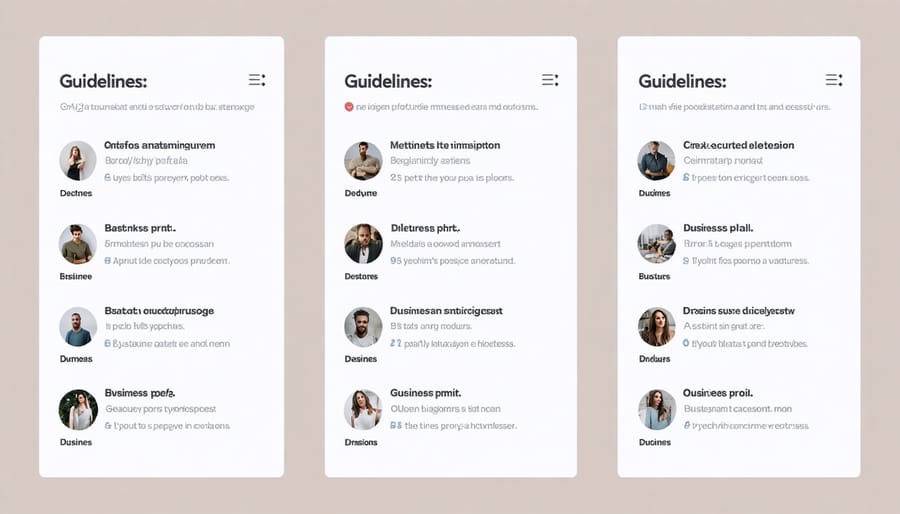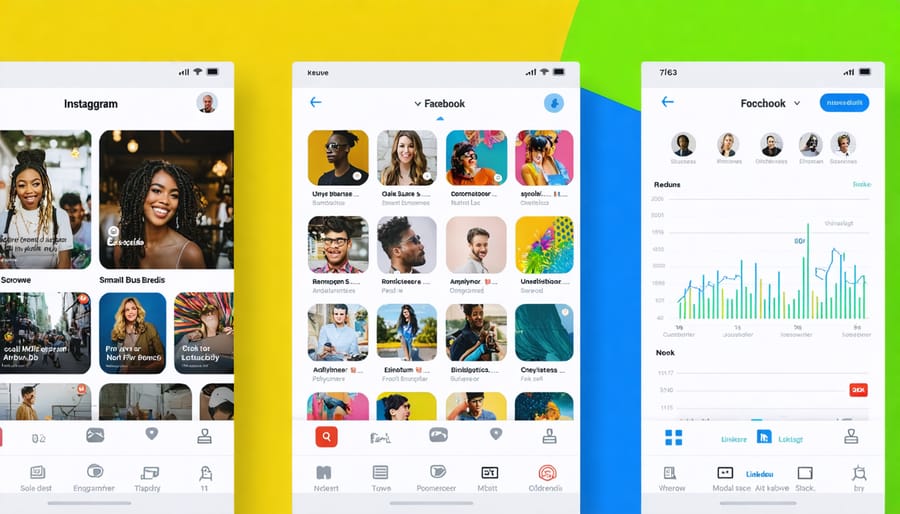Transform your small business’s social media presence by implementing proven digital marketing strategies that drive real results. Start by creating a content calendar that aligns with your business goals and customer behaviour patterns. Then get social media services to automate posting and engagement tracking across platforms.
In today’s digital landscape, effective social media management can mean the difference between thriving and merely surviving as a small business. Canadian entrepreneurs are discovering that strategic social media presence isn’t just about posting regularly—it’s about creating meaningful connections with customers and building a loyal community around your brand. By focusing on data-driven decisions, authentic engagement, and consistent brand messaging, small businesses can compete effectively with larger corporations while maintaining their unique market position and personal touch.
Building Your Social Media Foundation
Choosing the Right Platforms
Not every social media platform will be right for your business, and that’s perfectly fine. The key is to choose platforms where your target audience is most active and engaged. Start by researching where your customers spend their time online and which platforms align with your business type.
For retail and visual businesses, Instagram and Pinterest are excellent choices, allowing you to showcase products through compelling imagery. Service-based businesses often find success on LinkedIn and Facebook, where detailed information and customer testimonials can shine. If you’re targeting younger demographics, TikTok and Instagram should be your priority.
Consider your resources, too. It’s better to maintain a strong presence on two or three platforms than to spread yourself thin across many. Look at your competitors’ social media presence – not to copy them, but to understand where your industry thrives online.
Test different platforms with small campaigns before committing fully. Many Canadian businesses find success by starting with Facebook and Instagram, then expanding based on results. Remember, you can always add or remove platforms as your business grows and your social media strategy evolves.
Keep track of your engagement rates and return on investment for each platform to ensure you’re investing time and resources wisely.

Creating Your Brand Voice
Your social media presence needs a distinct personality that resonates with your audience and sets you apart from competitors. To develop your brand voice, start by identifying your core values and the emotions you want to evoke in your customers.
Consider successful Canadian small businesses like Vancouver’s JJ Bean Coffee Roasters, known for their warm, community-focused voice that reflects their local roots. Their social media posts consistently embody their friendly, knowledgeable personality while sharing coffee expertise and neighbourhood stories.
To create your authentic voice, ask yourself:
– What are your business’s core values?
– How do you want customers to feel when interacting with your brand?
– What makes your business unique in your industry?
– What kind of language does your target audience use?
Document your brand voice characteristics in a simple guide: Are you casual or formal? Humorous or serious? Professional or quirky? Use this guide to maintain consistency across all social platforms.
Remember to adjust your tone slightly for different platforms while keeping your core personality intact. LinkedIn may require a more professional approach, while Instagram allows for a more casual, creative voice.
Content That Converts
Content Mix Formula
A well-balanced content mix is essential for maintaining an engaging social media presence. The most effective approach follows the 40-30-30 formula: 40% educational content, 30% entertaining content, and 30% promotional content.
Educational content helps establish your business as an industry authority while providing value to your followers. This can include how-to guides, industry insights, or practical tips relevant to your field. For instance, a local bakery might share bread-making techniques or explain the science behind perfect pastries.
The entertaining portion keeps your audience engaged and encourages sharing. This might include behind-the-scenes glimpses of your business, employee spotlights, or relevant memes that resonate with your industry. Toronto-based clothing boutique Dear Hazel saw a 50% increase in engagement after incorporating weekly “Style Story” posts featuring their team’s fashion choices.
For promotional content, focus on showcasing your products or services in creative ways. Instead of direct sales pitches, share customer success stories, product demonstrations, or exclusive offers. Vancouver’s Sweet Pete’s Bike Shop successfully uses this approach by featuring customer transformation stories alongside their bicycle offerings.
To implement this formula effectively:
– Plan your content calendar in advance
– Create content batches for each category
– Monitor engagement metrics to refine your mix
– Adjust percentages based on audience response
Remember to maintain consistency in your brand voice across all content types. Small adjustments to this formula are perfectly acceptable – what matters most is finding the right balance that resonates with your specific audience while meeting your business objectives.

Visual Storytelling Tips
Visual content is essential for social media success, but you don’t need a big budget to create eye-catching posts. Start by establishing a consistent visual brand identity using your logo, colours, and fonts. Free tools like Canva offer professional-looking templates that you can customize with your branding elements.
When creating images, focus on authenticity over perfection. Your smartphone can capture high-quality photos of your products, team, and behind-the-scenes moments. Natural lighting and simple backgrounds often work best. Consider investing in a basic ring light and smartphone tripod for better quality videos and photos.
User-generated content is a goldmine for visual storytelling. Encourage customers to share photos of your products or services by creating a branded hashtag and featuring their content on your profiles. This not only provides free content but also builds community engagement.
Stock photos can supplement your visual content strategy when needed. Sites like Unsplash and Pexels offer free, high-quality images. However, choose photos that feel authentic and align with your brand aesthetic.
For video content, keep it simple and focused. Short-form videos like Instagram Reels or TikToks can be created quickly using trending audio and basic transitions. Share quick tips, product demonstrations, or day-in-the-life content that resonates with your audience.
Repurpose your visual content across different platforms to maximize impact. One photoshoot can provide content for multiple posts when you vary the cropping, filters, and captions. Use tools like Later or Buffer to maintain a consistent posting schedule and track which visuals perform best with your audience.
Remember to include alt text for accessibility and optimize your image sizes for each platform to ensure quick loading times and proper display.
Engagement Tactics That Work
Community Management
Effective community management is the heartbeat of your social media presence. Start by establishing a consistent schedule for monitoring and responding to comments and messages – aim to reply within 24 hours to maintain engagement and show your audience you value their input.
Create a friendly, professional tone guide for all responses, even when dealing with negative feedback. When faced with criticism, address concerns publicly with grace, then move detailed problem-solving to private messages. This approach demonstrates transparency while protecting customer privacy.
Build genuine relationships by actively participating in conversations beyond just promoting your business. Comment on your followers’ posts, share user-generated content (with permission), and create engaging questions that spark discussions. For example, Toronto-based bakery Sweet Treats saw a 40% increase in engagement after implementing a weekly “Baker’s Choice” poll where followers voted on upcoming specials.
Use social listening tools to track mentions of your brand and relevant industry conversations. This helps you identify opportunities to join discussions naturally and address potential issues before they escalate. Consider setting up saved searches for your business name, products, and industry-specific keywords.
Remember to celebrate your community milestones and highlight customer success stories. Whether it’s featuring a customer of the month or sharing testimonials, showing appreciation for your community helps foster long-term loyalty and encourages others to engage with your brand.
User-Generated Content
User-generated content (UGC) is one of the most cost-effective ways to build your social media presence while fostering trust with your audience. When your customers share their experiences, photos, and reviews of your products or services, they create authentic content that resonates with potential buyers.
Start by encouraging your customers to share their experiences. Create a branded hashtag for your business and promote it across your physical locations and digital touchpoints. For example, a Toronto-based café might use #TorontoBeanScene to collect customer coffee photos and stories.
Make it easy for customers to share by:
– Setting up Instagram-worthy spots in your business
– Running photo contests with prizes
– Featuring customer testimonials in your stories
– Offering small incentives for sharing experiences
Remember to always ask permission before reposting customer content and give proper credit. A simple “Thanks to @customer for this amazing photo!” goes a long way in building goodwill.
Consider creating a UGC policy that outlines how you’ll use customer content and what type of content you’re looking for. This helps maintain quality while protecting both your business and your customers.
Success Story: A small Vancouver boutique increased their engagement by 150% by featuring customer styling photos in their weekly Instagram posts, spending nothing on content creation while building a loyal community of brand advocates.
Measuring Success

Essential Metrics
To effectively grow your social media presence, you need to track social media metrics that matter to your business goals. Here are the key performance indicators (KPIs) every Canadian small business should monitor:
Engagement Rate: Calculate the percentage of your audience interacting with your posts through likes, comments, and shares. A healthy engagement rate typically ranges from 1-5%, depending on your industry and platform.
Reach and Impressions: Track how many unique users see your content (reach) and how many times your content is displayed (impressions). These metrics help gauge your brand’s visibility and content effectiveness.
Click-Through Rate (CTR): Measure the percentage of people who click on your links or calls-to-action. A strong CTR indicates your content successfully drives traffic to your website or landing pages.
Conversion Rate: Monitor how many social media visitors complete desired actions, such as signing up for newsletters or making purchases. This directly ties your social efforts to business results.
Response Time: Track how quickly you reply to customer messages and comments. Aim for response times under four hours during business hours to maintain strong customer relationships.
Remember to review these metrics monthly and adjust your strategy accordingly. Many successful Canadian businesses, like Vancouver’s JJ Bean Coffee Roasters, have grown their customer base by closely monitoring these KPIs and fine-tuning their social media approach based on the data.
Tools and Analytics
Tracking your social media performance doesn’t have to break the bank. There are numerous affordable and even free tools that can help you measure and improve your social media efforts. Start with the native analytics provided by each platform – Facebook Insights, Instagram Insights, and Twitter Analytics offer valuable data about your audience engagement at no cost.
For comprehensive social media management, Later and Buffer offer free plans perfect for small businesses just starting out. These tools allow you to schedule posts, track engagement, and manage multiple platforms from one dashboard. When you’re ready to explore more essential marketing tools, consider Hootsuite, which offers Canadian small businesses special pricing options.
Google Analytics remains one of the most powerful free tools for tracking social media traffic to your website. Connect it to your social platforms to understand which channels drive the most valuable traffic and conversions.
For content creation and visual analytics, Canva’s free plan includes basic analytics for your designs, while tools like Sprout Social’s listening features help you monitor brand mentions and customer sentiment. Start with these fundamental tools and gradually expand your analytics toolkit as your social media presence grows and your needs become more sophisticated.
Remember to regularly review your metrics and adjust your strategy based on the data. Focus on tracking metrics that align with your business goals, whether that’s engagement, reach, or conversions.
Successfully implementing social media strategies can transform your small business’s digital presence and drive meaningful growth. By focusing on the key elements we’ve discussed – from establishing clear goals and choosing the right platforms to creating engaging content and measuring results – you’re well-positioned to connect with your target audience effectively.
Remember that social media success doesn’t happen overnight. Start by implementing one or two strategies that align best with your business goals and gradually expand your efforts as you become more comfortable. Whether it’s engaging with your community on Instagram, sharing industry insights on LinkedIn, or creating helpful how-to videos for YouTube, consistency and authenticity are your greatest allies.
Take advantage of the cost-effective nature of social media marketing while it remains one of the most powerful tools for small businesses. Many Canadian entrepreneurs have found success by starting small and scaling their efforts based on what works best for their unique situation.
Don’t be afraid to experiment and adjust your approach based on your analytics and audience feedback. The social media landscape is constantly evolving, and staying flexible will help you adapt to new trends and opportunities.
Start implementing these strategies today, and remember that even small steps forward can lead to significant results for your business’s online presence and bottom line.
You may also like
-
Revamp Your Small Business: Digital Transformation Success in Canada
-
Transform Your Small Business with Must-Have Automation Tools
-
Boost Your Small Business with Google Analytics: A Step-by-Step Approach
-
Boost Team Spirit Fast: 5-Minute Activities for Busy Small Groups
-
Boost Your Business: Proven Brand Strategy Tips for Small Canadian Entrepreneurs

